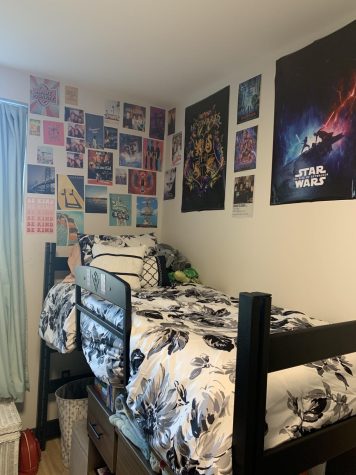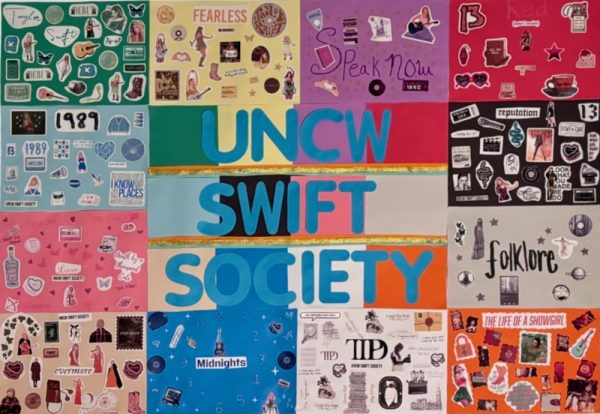OPINION: The ethicality of making students live in dorms
Oddly enough, college dormitories in the US are deeply entangled with America’s religious culture. In her book “Living on Campus: An Architectural History of the American Dormitory,” Carla Yanni discusses American colleges’ origins in the colonial era, where students would go to get an education in areas far from cities. At this time, colleges required on-campus living to create a close and pure community, devoid of the vices of the city. What made this inherently American was the lack of state religion, as Europe (the primary influence on American culture at the time) structured even elementary education around an established state religion. For early America, college was the time to create religious morality among future leaders and workers in America.
Within the colonial era, the setting of dorm life and college campuses was created to surround students with professors and enforce strict moral (typically Christian) teachings. It began as a way to not only create radically Christian environments but also environments for white men. To the early ruling class, education and college life provided a way for white men to retain power. They gained education and created echo chambers, only surrounded by people who looked like themselves.
The view of dorms being a way to center college life while simultaneously controlling students’ values is far from gone. The idea itself has simply evolved. On most college campuses, resident assistants (or RAs) live in the dorms. They’re typically students, a year or two older than the students on the floor, that enforce rules and regulations. This can include quiet hours, the number of guests per room and alcohol checks. While it is not the fault of the RAs for doing their jobs, the rules that they’re made to enforce are not conducive to a positive college environment.
For example, at UNCW, most dorms with freshmen have a front security desk and a check-in system for guests, while RAs are sent to make sure that the rooms don’t have guests overstaying. In the 2019-2020 school year, the rule was that members of the opposite sex could not stay over on weeknights, but members of the same sex could. If someone was not checked in as an overnight guest but was in past 12 am, the RAs would be sent to hunt them down.
While having an upperclassman do check-ins on younger students is a good idea, keeping people of the opposite sex from staying overnight is an attempt to control adolescent sex lives. With a culture more focused on proper sex education rather than abstinence, this feels unnecessary. Students who want to engage in relationships should be able to do so and can learn to manage the relationship alongside their other responsibilities.
In fact, the position of RA is most beneficial for pushing healthy talks on sex education. An older student who’s willing to help younger students is in a strong position to impose good values. The RA can have talks on sex that include STD and pregnancy prevention, balancing school and personal life and being a safe person to go to in the case of sexual assault. Having these conversations is important for college students to learn healthy boundaries that they may not have been taught before.
The formatting of dorms should be conducive to creating a safe space, leaving the RA in a strong position to facilitate this community and lead by example. Yet, they can’t protect and prevent everything within a hall, and the environment can become hard to manage when it comes down to relying on others’ responsibilities.
In hall-style bathrooms with small stalls and showers, there’s a lack of privacy. There’s hair clogging the drain that nobody wants to pick up and unflushed toilets. In a girls’ hall, there are often girls doing hair and make-up, which is perfectly fine. However, with a small shared space that 30 people are all using simultaneously, the hall-style bathroom is inconvenient to everyone. The sense of privacy that comes with a bathroom is left behind since if you throw up, it’s witnessed by others. There’s little space to change as the bathrooms are occupied and it’s hard to change in the small shower stalls, leading you to awkwardly trudge back to your room, towel or robe tightly around you, in an oddly vulnerable state.
The lack of privacy also applies to the room and the experience of having a roommate. Unless you choose to stay with a friend, it’s fairly normal to be stuck with a stranger. There are unknown boundaries, such as expectations for cleanliness. There’s the awkwardness of staying up later than your roommate and having to tip-toe around to not wake them up. There’s also a lack of alone time.

This can have consequences on students’ mental health, according to an article in The Atlantic on the consequences of small apartments in New York by Susan Saegert, a professor of environmental psychology at the City University of New York Graduate Center. She points out that in her studies on the effects of low-income housing within New York (that pertain to small apartments) that children tend to become withdrawn and have trouble studying. Students in dorms similarly lack privacy from peers and the necessary room to be in their own space, leaving it quite difficult to create a peaceful living situation.
Mini-fridges aren’t provided but can be rented, there is usually one kitchen per floor and the laundry is usually a free-for-all fight. The idea that people who just left their homes for the first time are able to automatically assume responsibility is flawed. People who make messes in the kitchen or clog the sink with soggy cheerios go undiscovered, nasty dishes hang around for months and the microwave could be covered with an explosion of mac and cheese, with the person responsible going unchecked. Clothes get stolen and students get blamed for not watching their own laundry close enough. All in all, large spaces such as dorms allow students to go unchecked by peers, whereas in apartment-style rooms, roommates can call out irresponsibility.
Before COVID, a concern students had to have in college was the “freshman flu”, which is an umbrella term for the colds and common illnesses that went around in a college dorm. In an article for the Washington Post, Dr. David Mcbride, the director of the University of Maryland Health Center, points to close quarter living as what enables illnesses to spread so rapidly.
UNCW saw the effects of dorm living during the spread of COVID-19. On Sept. 3, 2020, the university hit its biggest spike of 2020 with 38 positive cases in one day. On Sept. 8, 2020, UNCW released a statement on its decision to de-densify the campus by having first-year dorm rooms go to single occupancy. They cited that “The Health Department approached UNCW because 18-to-24-year-olds represent the largest source of new COVID-19 cases in the county.” A week after this decision, the COVID cases went down, with the largest spike in 2021 after de-densification being 21 positive cases on Sept. 22.
The close quarters of dorms and dependence on other peers to keep a clean space make it hard for students to maintain good health. While this can be fine among younger populations, it leaves behind those with underlying conditions who can be stuck on bed rest for weeks with a single illness.
UNCW recently implemented a rule that students admitted as first-year students had to live on campus for two years, with the housing and residency page stating that “students admitted as a First Year student will be required to live in on-campus housing for their first and second academic years.” They claimed that “academic and student success comes first at UNC Wilmington. We know, through many decades of research, that students who reside and eat on-campus make a smoother transition to collegiate life, develop strong friendships, achieve higher grade point averages, and persist to graduation at higher rates.”
The study UNCW is referring to is likely the study by Dr. C Lockwood Reynolds, who stated that dorm living helped students who did poorly in high school do well in college but had little effect on students in the upper echelon of classes. Dr. Reynolds also stated that this was likely because of the collaborative learning environment given to students and that the pandemic would likely lessen this effect. It’s important to note that UNCW’s two-year housing policy was established in the spring of 2021 when there was still an ongoing pandemic.
Beyond this, one thing many students are forced to consider when deciding whether to live on or off-campus is cost. For example, next year the rate of living on campus in a second-year housing option, such as Seahawk Crossing, will be $8,638.00 which covers rent, utilities, internet, housekeeping and security. If you want to live on campus and have a car, you also have a parking fee, which is $390 for the year. The university itself closes over winter break, meaning students on campus have to go home. For students who have jobs, this may mean they’re cutting down on the time that they could work at their job.
On the alternative, for 12 months of living in Cottages at College Acres, apartments.com estimates the cost is $9,780. Living in this complex for nine months (around two semesters plus the duration of winter break) would be $7,335. A high estimate for apartments at Redpoint would be around $10,188 for 12 months and $7,641 for nine months.
Campus costs eliminate a necessary choice for students who may not be able to afford to live on campus two years in a row. UNCW’s cash grab isn’t for students’ benefit when it ignores the monetary issues students may face living on campus.
Dorm living is far from a doomed system and most definitely has its benefits. That being said, a school environment should be conducive to helping improve school life. RAs can be used as mentors on personal health that teach students about living on their own for the first time.
Students should be treated as adults learning to live on their own, not kids under a new parents’ roof. Dorm life should structure itself in a way that prioritizes the health and well-being of students. This comes with granting more space, better-shared space upkeep on the part of students as a collective, and overall enforcing rules among students to be beneficial to their future living situations.
Finally, in terms of costs, UNCW has been rebuilding for the last few years continuously and can maintain a better standard of living for students (including maintaining low COVID rates) if they removed the two-year campus living requirement. This would also allow students better living options in terms of money and the ability to remain in Wilmington over breaks, which is beneficial to students with jobs.
UNCW has the ability to consistently improve, and the main place to start should be creating the best possible environment for students by getting to the root of their everyday lives. At it’s heart, this environment relies on finances, a good home environment and healthy living. This should be the area of focus for improving students’ well-being.













Nick B • Apr 6, 2022 at 11:06 pm
This two year requirement is bombastic and absurd…and what of the people with no functional home to go back to? Dorm life is based on an antiquated model and not relevant in today’s world. The fact of the matter is dorm life should be a choice. It sounds more like another money grab by universities.